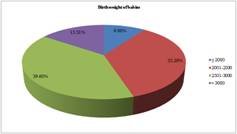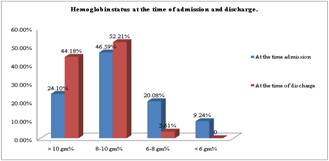 |
||||||||||||||||||||||||||||||||||||||||||||||||||||||||||||||||||||||||||||||||||||||||||||||||||||||||||||||||||||
|
|
||||||||||||||||||||||||||||||||||||||||||||||||||||||||||||||||||||||||||||||||||||||||||||||||||||||||||||||||||||
 |
||||||||||||||||||||||||||||||||||||||||||||||||||||||||||||||||||||||||||||||||||||||||||||||||||||||||||||||||||||
|
|
[Abstract] [PDF] [HTML] [Linked References]
A Study of Immediate Outcome of Caesarian Section in Primiparous Patients
Laxmikant R. Kanade1, Nitin Naresh Kulkarni2* 1Associate Professor, 2Lecturer, Department of OBGY, A.C.P.M. Medical College, Dhule, Maharashtra, INDIA. *Corresponding Address: Research Article
Abstract: Introduction: The reasons for increased incidence of cesarean section in primiparous patients are obvious. Firstly, increased safety of this operation has widened the indications both maternal and fetal. Secondly, in the past, cesarean section used to be a last resort for delivery while now it is a method of choice over any unpredictable and unavoidable traumatic vaginal delivery. Also the increasing advances in assessing fetal maturity and fetal well being have improved the ability to use cesarean section in a more efficient manner. Thus the present study was undertaken to see the immediate outcome of cesarean section such as birth weight, APGAR score, post section hemoglobin status. Aims and objectives: To find out an immediate outcome of cesarean section in primiparous patients. Material and Methods: The present study was conducted at ACPM Medical College, Dhule. All the primiparous women attending the institute for the delivery and undergone cesarean section were enrolled in the study. Immediate outcome of cesarean section were recovered. Birth weight, APGAR score at 1 minute and 5 minute were recorded. Hemoglobin status at the time of admission and discharge was also recorded. Results: Incidence of cesarean section in primiparous women was 24.9%. Most common age group was young between 15 to 25 years. It was observed that 101 (39.60%) babies were weighing between 2500 to 3000 grams. There were a large majority of 170 (66.68%) babies with APGAR score more than 7 at 1 minute and 212 (83.15%) babies at 5 minutes. was observed that post cesarean section hemoglobin status was improved.
Introduction The appalling maternal mortality rate of cesareans continued until the beginning of the 20th century.1 In the Great Britain and Ireland, the maternal death rate from the operation in 1865 was 85%. In Paris, during the 90 years ending in 1876 not a single successful cesarean had been performed. Harris2 noted that as late as 1879, cesareans actually were more successful when performed by the patient herself or when the abdomen was ripped open by the horns of a bull. He collected from the literature nine such cases with five recoveries, and contrasted them with 12 cesareans performed in New York City during the same period, with only one recovery. The turning point of the evolution of cesarean came in 1882, when Max-Sanger, then a 28 year old assistant of Crede3 in university clinic at Leipzig, introduced suturing of uterine wall. The long neglect of so simple an expedient as uterine suture was not the result of oversight but stemmed from a deeply rooted belief that sutures in the uterus were superfluous as well as harmful by virtue of serving as the site for severe infection. In meeting these objections, Sanger, who had himself used sutures in only one case, documented their value not from sophisticated medical centers of Europe, but from frontier America. There in outposts from Ohio to Louisiana, 17 cesarean deliveries had been reported in which silver wire sutures had been used with the survival of eight mothers- an extra-ordinary record in those days. Although the introduction of uterine sutures reduced the mortality rate of operation from hemorrhage, generalized peritonitis remained the dominant cause of death. Hence, various types of operations were devised to combat this scourge. The earliest was the Porro procedure4 (1876), which combined subtotal cesarean hysterectomy with marsupalisation of cervical stump. The first extra peritoneal operation was described by Frank2 in 1907 and with various modifications, as introduced by Latzko (1909) and Waters5 (1940), was employed until recent years. Cesarean section – an operation mainly evolved to save a maternal life during difficult child birth has now become increasingly the procedure of choice in high risk situations to prevent perinatal morbidity and mortality. This has become possible because of sophisticated patient care depending on effective antimicrobials, blood transfusion services, superior monitoring systems rendering safer anesthesia, improved surgical techniques and reliable neonatal care backup services. Thus on the various factors output of cesarean section is dependent. The reasons for increased incidence of cesarean section in primiparous patients are obvious. Firstly, increased safety of this operation has widened the indications both maternal and fetal. Secondly, in the past, cesarean section used to be a last resort for delivery while now it is a method of choice over any unpredictable and unavoidable traumatic vaginal delivery. Also the increasing advances in assessing fetal maturity and fetal well being have improved the ability to use cesarean section in a more efficient manner. Thus the present study was undertaken to see the immediate outcome of cesarean section such as birth weight, APGAR score, post section hemoglobin status.
Aims and Objectives
Material and Methods The present study was conducted at ACPM Medical College, Dhule. Study Design The present study was conducted at ACPM Medical College, Dhule. All the primiparous women attending the institute for the delivery were enrolled in the study. Study Duration April 2013 to March 2014. All the primiparous women coming to the institute for delivery were observed for mode of delivery. Among these women who under gone cesarean section were further studied. Thus total 249 primiparous women underwent cesarean section during the study duration. Information regarding type of operation, birth weight of baby was noted down on a prestructured proforma. Apgar score was calculated for each baby delivered by cesarean section in primis at one minute and at five minutes. Number of blood transfusion given was also recorded. Hemoglobin status of all the study population at the time of admission and at the time of discharge was measured and compared.
Results
Table 1: Age wise distribution of women
Majority i.e. 91.55% of patients were between 15 to 25 years. 4 were elderly primiparous patients.
Table 2: Distribution of women according to the type of operation
It was observed that only 14 (5.62%) cases had elective cesarean while remaining 235 cases were divided into two groups. First group includes the cases which were directly taken for cesarean section on admission. It consists of 32.14% cases. Second group consist of Cases taken for cesarean section after observing the progress of labor i.e. in the form of fetal distress, cervical dystocia, prolonged labor, etc. and it consist of 62.24% cases.
Table 3: Distribution of babies according to birth weight
*There were 6 twin babies.
While studying the birth weight of babies it was observed that 101 (39.60%) babies were weighing between 2500 to 3000 grams. There were 25 (9.80%) babies having weight less than 2000 grams, two of them were premature and 14 were intrauterine growth restricted babies. 39 (15.31%) babies were weighing more than 3000 grams.
Table 4: Distribution of babies according Apgar score
Apgar score was also measured at 1 min and at 5 min. It was observed that 23 (9.01%) babies had Apgar score less than 3 at 1 minute and at 5 minutes 6 (2.35%) had less than 3. There were 62 (24.31%) with Apgar score between 3 and 7 out of which 37 (14.5%) babies continued having the same score at 5 minutes. There were a large majority of 170 (66.68%) babies with Apgar score more than 7 at 1 minute and 212 (83.15%) babies at 5 minutes.
Table 5: Of women according to no. of blood transfusions required
No blood transfusion was required in 90 (36.14%) cases. Whereas in 80 (32.13%) cases only one transfusion was required cases. two or more transfusions required in 31.2% cases.
Table 6: Distribution of women according Hemoglobin status at the time of admission and discharge
It was observed that post cesarean section hemoglobin status was improved. It was because hemoglobin correction was done pre or intra operatively. Thus it was observed that there were 24.1% women were having Hb more than 10gm% at the time of admission whereas 44.18% were having Hb more than 10gm% at the time of discharge.
Discussion The present study was carried with the aim to find out immediate outcome of cesarean section in primiparous patients. Total 249 primiparous patients had undergone cesarean section in this institute during the period of one year (FEB. 2002 to Dec. 2002). It was seen that 91.55 percent of cases were between 15 to 25 years. This can be explained on the basis of early marriages in our country and consequently early child-bearing. In present study emergency cesarean section was done in 32.14 % women. In 62.24% cases efforts were taken for normal delivery. But when the progress of labor was not satisfactory then decision was taken. Various reasons were present for unsatisfactory progress of labor such as fetal distress, cervical dystocia, prolonged labor, etc. There were 25 (9.80%) babies having weight less than 2000 grams, two of them were premature and 14 were intrauterine growth restricted babies. While studying the birth weight of babies it was observed that 101 (39.60%) babies were weighing between 2500 to 3000 grams. Apgar score was assessed in all the babies at one and five minute’s interval. The Apgar scale is determined by evaluating the newborn baby on five simple criteria on a scale from zero to two, then summing up the five values thus obtained. The resulting Apgar score ranges from zero to 10. The five criteria are summarized using words chosen to form backronym (Appearance, Pulse, Grimace, Activity, Respiration).6 In the present series 23 (9.01%) babies had Apgar score less than 3 at 1 minute, at 5 minutes 6 (2.35%) had less than 3. There were 62 (24.31%) babies with Apgar score between 3 and 7 out of which 37 (14.5%) babies continued having the same score at 5 minutes. The majority of babies i.e. 170 (66.68%) had Apgar score more than 7 at 1 minute and 212 (83.15%) babies at 5 minutes. There was no any early neonatal death. Similar findings were found by Meis (1978)7, Kenneth (1991)8, Hari Bhaskar (1997)9 There was no maternal mortality. In most of the cases post-operative period was uneventful. 15 (6.02%) cases had post-operative pyrexia, wound sepsis, etc and which was treated accordingly. Hemoglobin status of the mother was assessed at the time of admission and discharge. Blood transfusion was given according to hemoglobin levels on second postoperative day. No patient had hemoglobin less than 8 gm% at the time of discharge. 159 patients were given blood transfusion according to the need. No blood transfusion was required in 90 (36.14%) cases. Whereas in 80 (32.13%) cases only one transfusion was required cases. two or more transfusions required in 31.2% cases. Requirement of transfusion was decided according to preoperative and post operative hemoglobin levels. It was observed that there were 24.1% women were having Hb more than 10gm% at the time of admission whereas 44.18% were having Hb more than 10gm% at the time of discharge. Thus it was observed that post cesarean section hemoglobin status was improved. It was because hemoglobin correction was done pre or intra operatively.
Conclusion Thus finally we can conclude that immediate outcome of cesarean section in primiparous women was better. As no maternal mortality was noted and birt weight and apgar score in the babies was good.
Acknowledgement We express our sincere gratitude to Staff of OBGY Department, ACPM Medical College and Hospital, Dhule for the whole hearted support and co-operation without which this venture would not have materialized.
References
|
|||||||||||||||||||||||||||||||||||||||||||||||||||||||||||||||||||||||||||||||||||||||||||||||||||||||||||||||||||
|
||||||||||||||||||||||||||||||||||||||||||||||||||||||||||||||||||||||||||||||||||||||||||||||||||||||||||||||||||||


